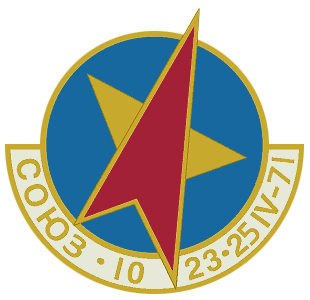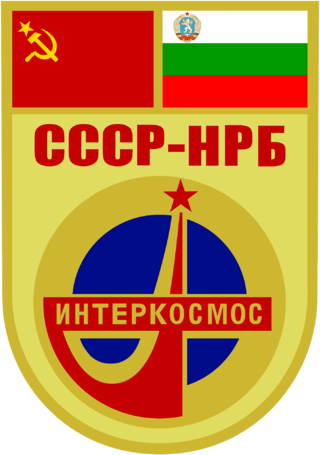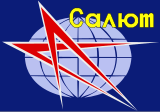
The Salyut programme was the first space station programme, undertaken by the Soviet Union. It involved a series of four crewed scientific research space stations and two crewed military reconnaissance space stations over a period of 15 years, from 1971 to 1986. Two other Salyut launches failed. In one respect, Salyut had the task of carrying out long-term research into the problems of living in space and a variety of astronomical, biological and Earth-resources experiments, and on the other hand the USSR used this civilian programme as a cover for the highly secretive military Almaz stations, which flew under the Salyut designation. Salyut 1, the first station in the programme, became the world's first crewed space station.

Soyuz 7K-T No.39, was an unsuccessful launch of a crewed Soyuz spacecraft by the Soviet Union in 1975. The mission was expected to dock with the orbiting Salyut 4 space station, but due to a failure of the Soyuz launch vehicle the crew failed to make orbit. The crew consisted of commander Vasily Lazarev, and flight engineer Oleg Makarov, a civilian. Although the mission was aborted and did not accomplish its objective, the craft exceeded common space boundaries and therefore is recognized as a sub-orbital spaceflight, which the crew survived. The crew, who initially feared they had landed in China, were successfully recovered.

Soyuz 10 was launched on 22 April 1971 as the world's first mission to the world's first space station, the Soviet Salyut 1. The docking was not successful and the crew, Vladimir Shatalov, Aleksei Yeliseyev, and Nikolai Rukavishnikov, returned to Earth without having entered the station. Following difficulties in docking pairs of Soyuz capsules, this would be the first of numerous docking failures in the Soviet space station program.

Soyuz 12 was a September, 1973, crewed test flight by the Soviet Union of the newly redesigned Soyuz 7K-T spacecraft that was intended to provide greater crew safety in the wake of the Soyuz 11 tragedy. The flight marked the return of the Soviets to crewed space operations after the 1971 accident. The crew capacity of the capsule had been decreased from three to two cosmonauts to allow for pressure suits to be worn during launch, re-entry and docking. It was the first time pressure suits were used for reentry since the Voskhod 2 flight.

Salyut 1 (DOS-1) was the world's first space station launched into low Earth orbit by the Soviet Union on April 19, 1971. The Salyut program followed this with five more successful launches of seven more stations. The final module of the program, Zvezda (DOS-8), became the core of the Russian segment of the International Space Station and remains in orbit.

Salyut 3 was a Soviet space station launched on 25 June 1974. It was the second Almaz military space station, and the first such station to be launched successfully. It was included in the Salyut program to disguise its true military nature. Due to the military nature of the station, the Soviet Union was reluctant to release information about its design, and about the missions relating to the station.

Salyut 5, also known as OPS-3, was a Soviet space station. Launched in 1976 as part of the Salyut programme, it was the third and last Almaz space station to be launched for the Soviet military. Two Soyuz missions visited the station, each crewed by two cosmonauts. A third Soyuz mission attempted to visit the station, but failed to dock, whilst a fourth mission was planned but never launched.

Salyut 6, DOS-5, was a Soviet orbital space station, the eighth station of the Salyut programme. It was launched on 29 September 1977 by a Proton rocket. Salyut 6 was the first space station to receive large numbers of crewed and uncrewed spacecraft for human habitation, crew transfer, international participation and resupply, establishing precedents for station life and operations which were enhanced on Mir and the International Space Station.

Salyut 7 was a space station in low Earth orbit from April 1982 to February 1991. It was first crewed in May 1982 with two crew via Soyuz T-5, and last visited in June 1986, by Soyuz T-15. Various crew and modules were used over its lifetime, including 12 crewed and 15 uncrewed launches in total. Supporting spacecraft included the Soyuz T, Progress, and TKS spacecraft.

The Almaz program was a highly secret Soviet military space station program, begun in the early 1960s.

Soyuz 33 was an April, 1979, Soviet crewed space flight to the Salyut 6 space station. It was the ninth mission to the orbiting facility, but an engine failure forced the mission to be aborted, and the crew had to return to Earth before docking with the station. It was the first failure of a Soyuz engine during orbital operations.
Soyuz 35 was a 1980 Soviet crewed space flight to the Salyut 6 space station. It was the 10th mission to and eighth successful docking at the orbiting facility. The Soyuz 35 crew were the fourth long-duration crew to man the space station.
Soyuz T-8 was a crewed mission to the Salyut 7 space station in 1983. Shortly into the mission, the spacecraft failed to dock with the space station due to an incident involving an antenna being torn off the craft by the protective launch shroud. After a fuel-consuming attempt made in darkness for an optical rendezvous with Salyut 7 resulted in an abort in order to avoid collision, it was decided to de-orbit T-8 two days into the mission in order to ensure that the spacecraft had a sufficient amount of propellant for the de-orbit maneuver. After de-orbiting, landing of the craft occurred normally.

Soyuz 7K-ST No.16L, sometimes known as Soyuz T-10a or Soyuz T-10-1, was an unsuccessful Soyuz mission intended to visit the Salyut 7 space station, which was occupied by the Soyuz T-9 crew. However, it never finished its launch countdown; the launch vehicle was destroyed on the launch pad by fire on 26 September 1983. The launch escape system of the Soyuz spacecraft fired six seconds before the launch vehicle exploded, saving the crew. As of 2022, it remains the only time a launch escape system has been fired before launch with a crew aboard.

Soyuz T-12 was the seventh crewed spaceflight to the Soviet space station Salyut 7. The name "Soyuz T-12" is also the name of the spacecraft used to launch and land the mission's three-person crew. The mission occurred in July 1984, during the long-duration expedition Salyut 7 EO-3. During the mission, crew member Svetlana Savitskaya became the first woman to ever perform a spacewalk, and the potential Buran space shuttle pilot, Igor Volk, was given spaceflight experience. Unlike many Soyuz visiting missions, the Soyuz lifeboats were not swapped, and the crew returned to Earth in the same spacecraft in which they launched.

Progress 1, was a Soviet unmanned Progress cargo spacecraft which was launched in 1978 to resupply the Salyut 6 space station. It was the maiden flight of the Progress spacecraft, and used the Progress 7K-TG configuration. It carried supplies for the EO-1 crew aboard Salyut 6, which consisted of Soviet cosmonauts Yuri Romanenko and Georgy Grechko. The cargo carried by Progress 1 also included equipment for conducting scientific research, and fuel for adjusting the station's orbit and performing manoeuvres.

Mir, DOS-7, was the first module of the Soviet/Russian Mir space station complex, in low Earth orbit from 1986 to 2001. Generally referred to as either the core module or base block, the module was launched on 20 February 1986 on a Proton-K rocket from LC-200/39 at the Baikonur Cosmodrome. The spacecraft was generally similar in design to the two previous Soviet orbital stations, Salyut 6 and Salyut 7, however possessed a revolutionary addition in the form of a multiple docking node at the forward end of the module. This, in addition to the docking port at the rear of the spacecraft, allowed five additional modules to be docked directly to DOS-7, greatly expanding the station's capabilities.

Soyuz 7K-OK was the first generation of Soyuz spacecraft and was flown between 1967 and 1971. The 7K-OK was used for the first ferry flights to the Salyut space station program, beginning a long history of space station service that continues today with the International Space Station (ISS).

Progress 2 was an unmanned Progress cargo spacecraft launched by the Soviet Union in 1978 to resupply the Salyut 6 space station. It used the Progress 7K-TG configuration, and was the second Progress mission to Salyut 6. It carried supplies for the EO-2 crew aboard Salyut 6, as well as equipment for conducting scientific research, and fuel for adjusting the station's orbit and performing manoeuvres.















